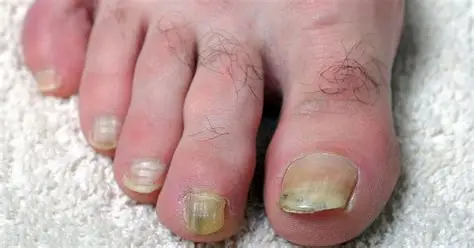Fungi grow in and around your nails, causing them to thicken and become yellow or white. The nail may also become brittle or crumble.
Fungal nail infections are very common. They can affect anyone. They are more likely to affect older adults and those who have a condition such as diabetes that reduces blood flow to the feet.
Moisture
Fungal organisms thrive in warm, moist environments, making the toenails a prime target for infection. This condition is often ignored because it doesn’t cause pain at the outset. But if left untreated, it can worsen and lead to other foot problems like calluses, bunions or hammertoes. Eventually, the toenail becomes discolored, thickened or brittle, making it unsightly and painful to wear shoes that put pressure on the feet.
The technical name for nail fungus is onychomycosis. It’s much more common than people realize, and it can be a serious health issue that requires treatment. The infection can spread between toes, from one foot to another, and even to the rest of your body if you have a suppressed immune system due to diabetes or certain medications.
Toenail fungus can start with a small white or yellow spot underneath a fingernail or toenail. Over time, the fungus spreads and can turn your nail white, yellow, green or black. It also becomes brittle and can crumble when you touch it. It can also create a foul odor.
Fungus is usually caused by a type of mold called a dermatophyte, though yeast and bacteria can also cause it. The fungi are too tiny to see without a microscope, but they can grow on any surface where they find warmth and moisture. They often live in the public areas of swimming pools, locker rooms and communal showers, where they can infect people who walk barefoot there.
Nail fungus can be difficult to treat, especially because it’s contagious. Your healthcare provider may take a sample of your toenail and examine it under a microscope to confirm the fungus is present, and what type it is. They can then prescribe a medication for you to take or a topical antifungal agent that you apply directly to the nail.
There are a few things you can do to help prevent toenail fungus, such as keeping your nails dry and wearing well-fitting shoes that don’t squeeze your toes. You can also avoid wearing sandals or flip-flops in public places where fungus is commonly found, and you should change your socks daily and remove them immediately after exercising.

Heat
Fungi are microscopic organisms that grow in warm, moist places and thrive on keratin—the protein found in your fingernails and toenails. They’re responsible for most toenail fungal infections, or tinea unguium (medically called onychomycosis).
Fungus can invade your nails in two ways: a fungus under the nail or on the surface of the nail. The most common type of onychomycosis is distal subungual onychomycosis, which affects the entire nail from the base to the tip and causes it to become thick, brittle, yellow or brown. You might also notice that the nail separates from the skin underneath it in some spots. This type of toenail fungus isn’t painful, but it can be unsightly.
Another less common type of onychomycosis—white superficial onychomycosis—affects the nail surface only and is less severe than distal subungual onychomycosis. This condition can make your nails look white, chalky, and powdery. While it’s not as damaging as the other types of onychomycosis, white superficial onychomycosis can still make your nails brittle and discolored.
A fungal nail infection can be hard to treat, especially if it has been going on for a long time. But you can take steps to prevent it from occurring in the first place:
Keep your nails and cuticles as healthy as possible. Trim your nails straight across and avoid cutting the corners, which can lead to ingrown toenails. Wear shoes that fit well and allow your feet to breathe. Use antifungal foot powder and change your socks frequently, especially if your feet sweat a lot. Avoid walking barefoot in public showers, locker rooms and pool areas. Avoid sharing shoes, socks or towels.
If you do develop a toenail fungus, it’s important to see your doctor right away. They can recommend treatments such as over-the-counter topical creams, oral prescription pills or laser therapy to remove the affected nail and reduce the chances of the fungus spreading to other toenails. In some cases, the fungus may need to be surgically removed, which requires a small procedure performed while the area is numb. This is usually only considered if other treatment options haven’t worked.
Nail Trimming
Fungus thrives in warm, dark, moist places and is more common in toenails than fingernails. The fungus can enter the nail through cracks or cuts and grow. This can lead to a rotting, discolored and thickened nail. It can also spread to other nails, skin or even the rest of your body. This is why it’s important to treat fungal toenails as early as possible.
There are several different ways to treat toenail fungus but the most effective is professional treatment. A fungus specialist can prescribe the right medication for you, whether it is a topical cream or oral antifungals. They can also teach you how to properly care for your feet in order to prevent the infection from returning or spreading.
Some people may be more prone to developing a toenail fungal infection than others. This could be due to a medical condition such as diabetes or simply the natural progression of aging. Additionally, if you are taking certain medications, including birth control or steroids, it can weaken your immune system and increase the risk of an infection.
A good preventative strategy is to wear open-toe shoes as much as possible and to change your socks daily. If you have to wear closed-toe shoes for work or other reasons, consider using a spray or powder that adds moisture control. It’s also a good idea to only visit nail salons that practice proper sterilization and hygiene. Be sure to bring your own nail clippers and file and ask that they not cut the cuticles, as this can cause tiny breaks in the skin and allow germs to get in.
If you have a severe case of toenail fungus, it is sometimes necessary to remove the infected nail so that a healthy new nail can grow. This is a minor procedure done while the area is numb. You can then choose to apply a special ointment that helps the nails regenerate or you can try to keep them as long as possible with regular treatments of an antifungal cream. If you don’t keep up with your treatment plan, the fungus will come back.
Shoes
Fungi love warm, moist environments, which is why they thrive in shoes. When fungi infect the nails, they cause tinea unguium, also known as onychomycosis. This infection affects the entire nail and the area surrounding it. The nails may thicken, discolor, swell and become painful. The infection can also spread to other nails, skin and even the scalp.
Fungus infects the nails by penetrating the nail bed and consuming the keratin, a protein that makes nails hard. The fungi also enter through tiny cracks in the nails, which can be caused by injury or trauma. These cracks are more common in toenails than fingernails, and can be the result of trauma, a fungal infection or wearing nail polish for long periods of time.
The fungi that create toenail fungus are very contagious, and can be spread through direct contact with an infected person, or by walking around barefoot in a public place where fungus thrives. People with compromised immune systems, circulation problems or conditions like diabetes are more susceptible to developing fungal infections in their nails.
Fungal infections in the feet and toenails can be extremely difficult to treat. A foot doctor can help patients break the cycle of infection with effective professional treatment, and prevent fungal toenails from recurring.
Fungus can be prevented by keeping your toenails and feet dry, especially if you have a history of nail fungus in the past. Wear closed-toed shoes with breathable materials such as leather or suede, and avoid tight shoes that put pressure on the toes. Wear socks made from material that wicks away moisture and change them often. Avoid going barefoot in public places where fungi thrive, and always wear sandals when showering. If you go to a nail salon, bring your own nail clippers and file and ask that they not cut your cuticles. Be careful about sharing towels, and only visit nail salons that disinfect their tools after each customer.
